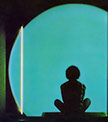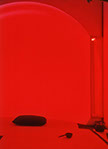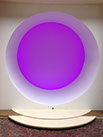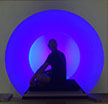


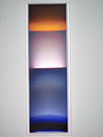


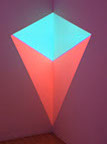
Hap Tivey began creating light installations and sculptures during the late sixties in Los Angeles. By 1973 he completed a complex of interior light environments that he exhibited privately in his Pasadena studio. These early creations reflected the influence of L.A. light artists such as Doug Wheeler and James Turrell, with whom he collaborated on large-scale search light structures. Throughout the 70’s he produced a large body of light installations in public galleries that invited viewers into large fields of undifferentiated light, where they experienced intensely saturated color with apparently infinite depth. Many of those works produced the impression of looking into deep cloudless skies. In the case of the Irvine and Spring Street Situations, a viewer was literally enveloped by empty color and ambiguous space.
His first commercial exhibition in New York at Blum Helman moved that impression of infinite light into the rectangle and onto the wall with a painting format that presented a surface of light rather than a surface of paint. In this new portable field, the viewer encountered the brilliant saturated colors of earlier installations only as auras that hovered around primary shapes of shifting silver light in a field of darkness. During the eighties, his shows at Blum Helman, Landau-Alexander, Margo Leavin and Elizabeth Leach expanded that palette of light into a full range of colors that maintained a sense of infinite light within a soft matte surface. The luminosity within the paintings was the result of ambient light in the room and would change with the time of day, type of illumination source, and position of the viewer. The works retained the interactive characteristic of the installations on a subtler scale.
Following the Museum of Modern Art’s acquisition, more of the gallery pieces found their way into shows and collections, and Tivey spent less time making public light installations and focused on creating a sculptural format that used the same materials as the paintings, but included a light source within the structure. Two important installations evolved during that period, the DeMenil house and the Picasso tearoom. The first was a dark light installation created for the ground floor of Christophe DeMenil’s Frank Gehry house. It involved columns of light hovering over surfaces of water in a darkened room. The second, created for Claude Picasso in his La Villette studio outside Paris, employed the same surface used on the sculptures for one wall of the room. At particular hours of the day, it allowed sun projections to articulate a sculptural structure embedded in the field of light. The Diane Brown show in New York saw a shift in Tivey’s presentation of light from an actual encounter to an abstraction of theoretical light and an illusion of luminosity. The Prudential Collection acquired most of that suite of images titled “Myth of the Machine”.
Tivey continued the development of light sculptures into the nineties, and as the computer’s graphic power evolved, he developed a technique of using pen-plotting machines to create images on light sensitive surfaces. These new images had the interactive properties of the earlier light paintings and sculptures, but like holograms shifting around and through fixed images, the light was pure refracted color, intensely saturated and responsive to the slightest movement of viewer or source. Digital imaging techniques developed during that time led to a series of video installations. The first series, presented in southern France, used a cave that had been sporadically inhabited for roughly five thousand years. Viewers entered the cave and after adapting to the darkness found one wall animated by digital projection. This exhibition continued for four years and evolved into the Origins project that spanned the next five. Origins consisted of almost an hour of animated images visually describing the theoretical beginning and condition of the universe. It presented a video projection on large multilayered screens and was accompanied by a suite of prints.
In 2004, Tivey returned to the format of the luminous painting with an installation at the new Elizabeth Leach Gallery. Since that time, he has created a new body of work that explores the potential of LED sources as luminous surfaces. The new work returns to his early presentation of light as a tangible presence with infinite depth. The subdued, almost encaustic colors of the seventies and eighties were replaced by purer hues, not as spectral as the digital light, but expressive in a greater range of values and tonalities. The infinite space of sky light dominates this work, but the structures resonate between solid forms and empty fields. This last body of work distills many of the techniques and subtleties he discovered during the previous three decades into simple powerful statements of pure light.
In two of his most recent installations, he returned to large-scale presentations of light in space. The “AAAL Enso” and the “Beverly Enso” presented cylinders of light facing shifting compositions that presented light similar to his earliest immersion environments.
For more than thirty years, Tivey's art has investigated the phenomena of light. In installation, painting, sculpture and projection, he pursued the concrete experience of light as well as the emotional and theoretical implications it holds for the human condition.

